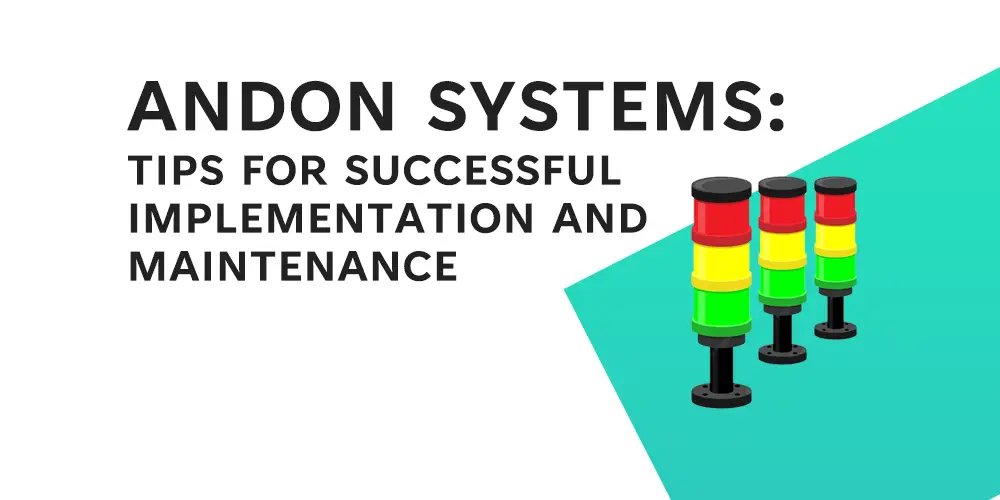Maintaining a competitive edge in today’s fast-paced business environment necessitates continuous improvement in all aspects of operations. Production processes are one area that can benefit greatly from improvement, and an Andon system can help achieve that improvement. An Andon system is a visual management tool for monitoring manufacturing processes and quickly identifying and resolving issues. Andon systems, when properly implemented and maintained, can assist businesses in improving quality, productivity, and safety.
However, implementing and maintaining an Andon system can be difficult, especially if you are unfamiliar with the concept. That is why we will provide tips and best practices for successful Andon system implementation and maintenance in this blog post. These tips can help you get the most out of your Andon system and achieve your operational goals, whether you work in manufacturing or another industry.
Table of Contents
Definition of Andon Systems and Their Purpose

An Andon system is a visual management tool for monitoring manufacturing processes and quickly identifying and resolving issues. It is a system that allows workers to signal a problem in the manufacturing process, whether it is a defect, a delay, or a quality issue, so that it can be resolved as soon as possible. The Andon system is intended to make it simple for employees to communicate problems and for supervisors or management to respond to them.
The goal of an Andon system is to increase the overall efficiency of the manufacturing process. It enables the rapid identification and resolution of issues, which can reduce downtime, improve quality, and boost productivity. Andon systems can also improve worker and management safety by quickly alerting them to potential hazards.
Andon System Types
Andon systems are classified into three types: manual, semi-automatic, and fully automatic.
Manual Andon System: The simplest type of Andon system is the manual Andon system. A worker physically pushes a button or pulls a cord to signal a problem. The signal can take the form of a light, a sound, or both. When the signal is received, the supervisor or management can address the issue.
Semi-Automatic Andon System: An Andon system that is semi-automatic is more advanced than a manual system. Sensors detect and automatically signal problems in the manufacturing process. A sensor, for example, could detect a flaw in a product and send out a light or sound signal.
Fully Automatic Andon System: The most advanced type of Andon system is a fully automatic Andon system. It employs sensors that not only detect but also automatically correct a problem. For example, a sensor may detect a flaw and automatically halt production until the problem is resolved.
Useful Andon System Examples
Andon systems are most commonly found in the manufacturing industry, but they can also be found in other industries. Here are a few real-world examples of Andon systems in action:
Automotive Manufacturing: Andon systems are used to signal quality issues on the production line in the automotive industry. When a defect is detected, a light or sound signal is activated, and the manufacturing process is halted until the problem is resolved.
Healthcare: In healthcare, Andon systems are used to signal patient safety issues, such as falls or medication errors. When an issue is detected, a light or sound signal is activated, and staff can respond.
Call Centers: Andon systems are used in call centers to signal call volume or service level issues. When call volume exceeds a certain threshold or service levels fall, a signal is sent to management, who can then respond by adding more staff or adjusting processes.
Understanding the fundamentals of Andon systems is essential for successful implementation and maintenance. Knowing the different types of Andon systems available and real-world examples of their use can help you select the best system for your company and maximize its benefits.
Tips for Implementing Andon Systems
Before implementing an Andon system, conduct a thorough analysis of your operations.
Before implementing an Andon system, it is critical to conduct a thorough analysis of your operations to identify areas where an Andon system would be beneficial. Consider the types of issues that frequently arise in your operations, their frequency and severity, and the impact they have on productivity, quality, and safety. This analysis will assist you in determining which Andon system is best suited to your requirements and how it should be configured.
Ensure employee buy-in and collaboration by involving them in the process.
Employees must be involved in the Andon system implementation process to ensure buy-in and collaboration. Seek employee feedback on how the system should be configured, what types of problems should be reported, and how the system should be used. This involvement will assist employees in understanding the system’s benefits and how it can improve their work environment.
Provide adequate training to employees on the Andon system and its use.
Employees must be trained to use the Andon system effectively. Provide training on the system’s purpose, how it works, how to signal a problem, and how to respond to signals. The training should be delivered in an easy-to-understand and apply format. This training will help ensure that employees use the system correctly and that it is an effective tool for improving operations.
Set specific goals and metrics for the success of the Andon system.
Setting clear goals and metrics for the success of the Andon system is critical to ensuring that it is used effectively. Determine the key performance indicators (KPIs) that will be used to assess the system’s success, such as reduced downtime, increased productivity, or better quality. Before implementing the system, establish baseline measurements for these KPIs and track them on a regular basis to evaluate the system’s effectiveness.
As needed, continuously evaluate and adjust the Andon system.
Finally, it is critical to evaluate and adjust the Andon system as needed. Review the system’s performance on a regular basis, identify any issues or areas for improvement, and make adjustments as needed. In addition, review the system’s configuration on a regular basis to ensure that it remains aligned with the changing needs of your operations.
Following these Andon system implementation tips can help ensure their success in improving your organization’s operations. Conducting a thorough analysis, involving employees, providing adequate training, establishing clear goals and metrics, and continuously evaluating and adjusting the system can result in increased productivity, improved quality, and a safer workplace.
Tips for Maintaining Andon Systems
Create a maintenance plan for the Andon system to keep it running smoothly.
To keep the Andon system running smoothly, a maintenance plan that includes regular inspections, cleaning, and servicing of the equipment is required. The plan should identify the specific Andon system components that require maintenance, the frequency of maintenance, and the procedures for carrying out maintenance tasks.
Test the Andon system on a regular basis to identify and resolve any issues.
Regular testing of the Andon system is required to ensure that it is operating properly and to identify and resolve any issues before they become major issues. The signaling devices, communication system, and response protocols should all be tested. Regular testing will assist in ensuring that the system is always available when needed and that it can be used to its full potential.
Ensure that employees understand how to report Andon system malfunctions
It is critical to ensure that employees understand how to report malfunctions or issues with the Andon system and that those reports are addressed as soon as possible. Employees should be trained on how to report system issues and who to contact if they encounter any. The reporting procedure should be simple and straightforward, and any issues that are reported should be addressed as soon as possible to minimize the impact on operations.
Identify opportunities for process improvement using data from the Andon system.
The data generated by the Andon system can be a useful tool for identifying process improvement opportunities. Data analysis can aid in identifying trends in the types of problems being reported, which can then be used to target specific areas for improvement. For example, if data shows that a specific workstation is frequently signaling problems, it may indicate that additional training or equipment is required to improve performance.
Following these Andon system maintenance tips can help to ensure that they continue to function effectively and provide value to your organization over time. Creating a maintenance plan, testing the system on a regular basis, training employees on how to report problems, and analyzing data to identify opportunities for improvement are all critical components of an effective Andon system maintenance program. You can help to ensure that your Andon system continues to provide value to your organization and supports your ongoing efforts to improve operations by implementing these best practices.
Andon System Implementation and Maintenance Best Practices
Incorporate Andon systems into your company’s continuous improvement culture.
It is critical to incorporate your Andon system into your company’s culture of continuous improvement to ensure its success. The Andon system should be viewed as a tool for identifying areas for improvement and facilitating their implementation. Encouraging employees to use the Andon system to report problems and suggest solutions will contribute to the development of a culture of continuous improvement, which can result in significant benefits for the organization.
Use Andon systems to promote workplace safety and positivity.
The Andon system can also be used to promote workplace safety and positivity. The Andon system can help to prevent workplace accidents and injuries by encouraging employees to report safety issues or potential safety hazards. Furthermore, the Andon system can be used to signal positive events, such as meeting production targets or recognizing outstanding performance, which can contribute to a more positive work environment and foster a sense of teamwork and collaboration.
Consider integrating Andon systems with other systems, such as Six Sigma or Lean manufacturing.
Integrating Andon systems with other systems, such as Lean manufacturing or Six Sigma, can provide the organization with additional benefits. Organizations can identify and eliminate waste, improve process flow, and increase overall efficiency by combining Andon systems with Lean manufacturing principles, for example. Similarly, integrating Andon systems with Six Sigma methodologies can aid in the identification and correction of defects or errors in the manufacturing process, resulting in higher product quality and customer satisfaction.
Following these best practices can help to ensure that Andon systems are successfully implemented and maintained in your organization. Incorporating Andon systems into your organization’s culture of continuous improvement, using the system to promote safety and a positive work environment, and integrating Andon systems with other systems can all provide significant benefits. Organizations can achieve higher levels of efficiency, productivity, and customer satisfaction by leveraging the power of Andon systems and other improvement methodologies, leading to long-term success and growth.
Conclusion
Andon systems are powerful tools that can assist organizations in identifying and addressing issues in real time, resulting in increased efficiency, quality, and safety. Organizations can successfully implement and maintain Andon systems by following the tips and best practices outlined in this blog post.
To ensure buy-in and collaboration, it’s critical to conduct a thorough analysis of your operations before implementing an Andon system. Adequate training, specific goals, and ongoing evaluation and adjustment are also required for success.
Maintaining the Andon system entails creating a maintenance plan, testing the system on a regular basis, and addressing malfunctions as soon as possible. Additionally, organizations can use data from the Andon system to identify process improvement opportunities.
Finally, integrating Andon systems into the company’s continuous improvement culture, using the system to promote safety and a positive work environment, and integrating Andon systems with other systems such as Lean manufacturing or Six Sigma can all provide additional benefits.
Organizations can achieve long-term success and growth by improving efficiency, quality, and safety in their operations by effectively implementing and maintaining Andon systems.








